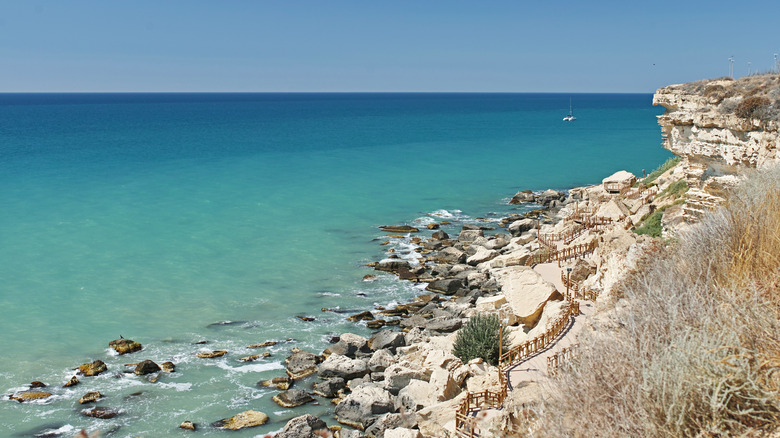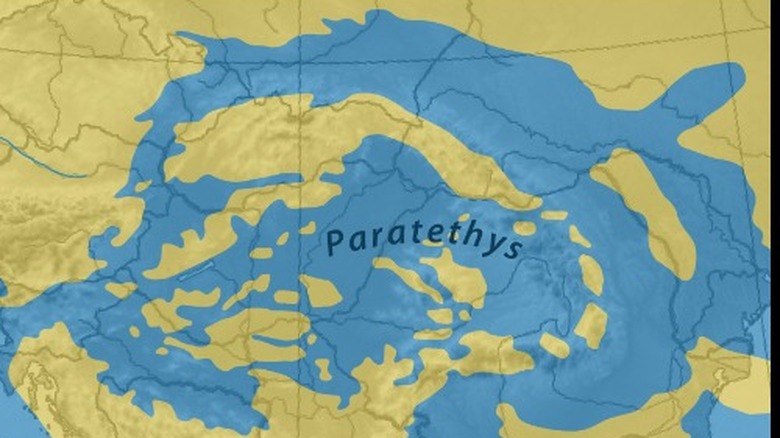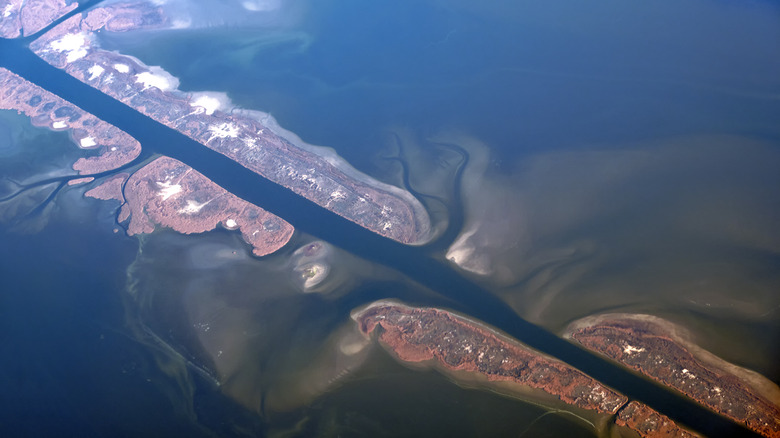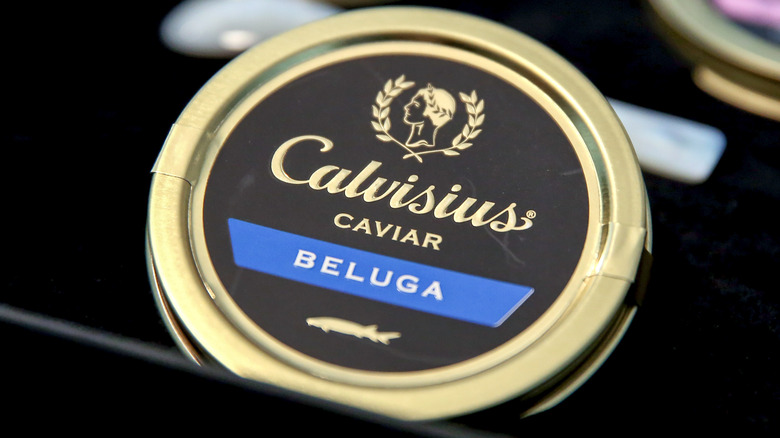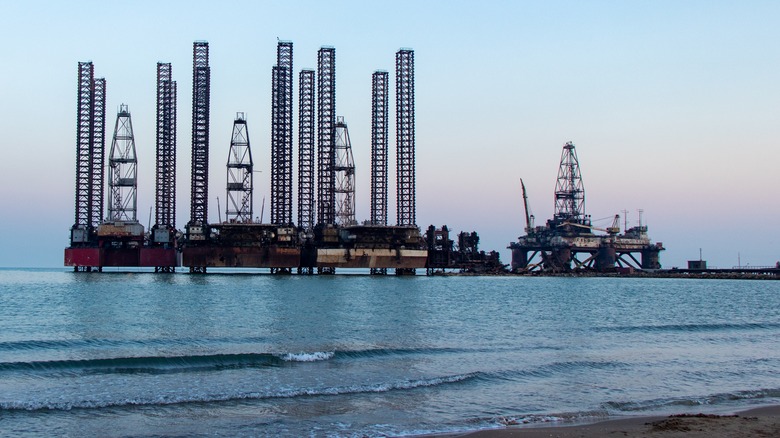Is The Caspian Sea Actually A Sea?
In more ways than one, the Caspian Sea is a body of water that floats between two worlds. It sits on the border of Europe and Asia. It was once part of an ancient sea and retains that origin in its salt content — about a third of the amount in regular seawater, according to Natural History. However, it now has no saltwater channel connecting it to the world's oceans, according to the Journal of Eurasian Studies.
Because of its unique geological features, there has been debate as to whether or not the so-called sea actually qualifies as a sea or as more of a lake. And because of its geographical position, this debate has political stakes. That's because seas and lakes are governed by different legal regimes, The Economist explains. International lakes are split equally between all of the countries along their coastlines, while seas are divided according to the UN's Law of the Sea, and this matters for the Caspian because all five countries along its edge want access to its natural resources. That's why in 2018, the five feuding countries finally agreed to the Caspian Sea's official status.
Oceanic origins
The Caspian Sea's unique characteristics are a part of its history. It began as part of the Paratethys Sea that linked to both the Atlantic and Indo-Pacific Oceans around 65 million years ago, according to Natural History. It isn't the only body of water to owe its origins to this prehistoric sea. The Black Sea, the Sea of Azov, and the Aral Sea all emerged from its waters as well. The seas ping-ponged back and forth between fresh and saltwater because of plate tectonics. Around 5 million years ago, the earth was forced upward, and sea levels fell, cutting the Caspian off from the wider ocean, according to NASA. However, a flow to the ocean was reestablished once again and then shut off around 2 million years ago, according to Natural History. Today, the Black Sea and the Sea of Azov retain their oceanic connections, but the Caspian Sea is entirely landlocked. The Aral Sea is also landlocked and is now a freshwater lake, according to National Geographic.
The Caspian Sea retains some characteristics of its oceanic origins, according to World Atlas. Its bottom is made of basalt like the seafloor rather than granite from the continent, its water is 1.2% salt, and it is large enough to form waves. Its size is the reason that the ancient Greeks and Persians confused it for an ocean and is, therefore, the reason it has its current name, according to NASA.
The Caspian today
With a surface area of 143,244 square miles, the Caspian Sea has the largest surface area of any inland body of water on the planet, according to Live Science. A sea is usually defined as a part of the ocean that is somewhat enclosed by land, according to National Geographic. The Caspian Sea clearly does not meet that definition and is also often called the world's largest lake. However, it is not the world's largest freshwater lake, according to Natural History. Instead, the freshwater lake with the largest surface area is Lake Superior, and the freshwater lake with the largest total amount of water is Lake Baikal.
The Caspian Sea is also unique as a body of water because it is endorheic, according to Live Science. This means that, while more than 130 rivers pump water into the Caspian, there is no outlet that drains water out. Freshwater can enter, but it can only leave by evaporating. This may be one reason why it has retained such a high salt content. The Caspian gets 80% of its freshwater from the Volga River that enters via the north. Other rivers that feed it include the Amu Darya, Kura, and Ural Rivers. Because these rivers enter via the north, the north of the lake is fresher than the south.
Hidden resources
Today, five countries lay claim to parts of the Caspian Sea's coastline, according to World Atlas. They are, clockwise from northeast to northwest, Kazakhstan, Turkmenistan, Iran, Azerbaijan, and Russia. The Caspian Sea hides many valuable resources beneath its waves, which is why all five of these countries want to control it, according to the Journal of Eurasian Studies. It's unusual formation means that many unique lifeforms evolved there. In fact, there are 331 species only found in its waters, including five species of sturgeon (via Natural History). The lake's most valuable sturgeon is the beluga, the originator of the famous caviar. The Caspian is actually home to 90% of all the sturgeon in the world (via Natural History).
In recent years, a new resource has overtaken the importance of fish in the not-sea, partly because it has been fished too heavily, according to the Journal of European Studies. That resource is oil, which has been discovered beneath the Caspian. In fact, the first offshore oil well was drilled there in 1820, and the oil and gas industry is now the main business in the Caspian (via Live Science).
Sea or Lake?
The presence of oil is part of why it matters whether the Caspian is technically a lake or a sea. If it's a lake, then the body of water and all the resources in it would simply be divided between all the nations that surround it, but no international body would have access, according to the Journal of Eurasian Studies. However, if it's a sea, it would be controlled by UN law, which means that both the bordering countries and international oil companies could make use of it.
When Russia was still the Soviet Union, there were only two nations fighting over it: the USSR and Iran, according to The Economist. The two nations decided to treat it as a lake and divide both its surface and its bed. However, in 1991, the former Soviet Republicans gained independence, according to Asia Society. This added new interests to the battle, and the dispute over the Caspian's status lasted 20 years, according to The Economist. Kazakhstan wanted the Caspian defined as a sea because it has the longest coastline, and sea surface and seabed rights closer to shore are apportioned according to the length of a country's coastline. Turkmenistan wanted to build a pipeline across the Caspian to export gas to Europe.
The agreement
On August 12, 2018, the five Caspian countries met to decide its status once and for all, according to The Economist. They reached an agreement called the Convention on the Legal Status of the Caspian Sea. According to the agreement, the Caspian is neither a sea nor a lake but a legal hodge-podge of both.
The agreement had the following stipulations: The Caspian's surface waters would be divided like a sea — each country would control the waters 15 nautical miles from its coast and fishing rights extending 10 nautical miles farther out; the seabed, including oil and gas deposits, would not be divided like a sea — each country would work out control between the two relevant parties; Caspian countries would be allowed to build pipelines if they got approval from the countries that controlled the parts of the seabed the pipeline would need to cross; and countries that don't border the Caspian would not be allowed to move their militaries across its waters.
Therefore, the Convention preserves the Caspian's status as a liminal space that slips from the grasp of easy categories the way its waves slip from the sand.
